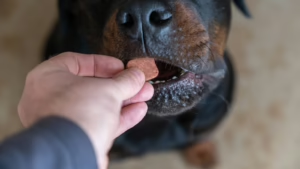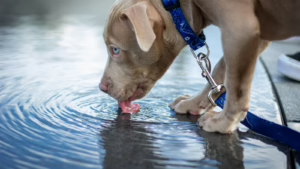4 Tips to Ensure Your Pet’s Good Health and Avoid Pet Obesity
Being overweight is just as detrimental to our dogs and cats as it is to us. However, unlike people, pets are at the mercy of their owners to assist them in the weight-loss process and to live a healthy lifestyle. Unfortunately, most owners are completely unaware that their pet is overweight. Obesity in pets is a growing epidemic, with 40% of dogs and cats being overweight or obese. Pet obesity can cause arthritis, diabetes, high blood pressure, kidney disease, certain cancers, heart and respiratory disease as well as lead to early death.
Despite being one of the most preventable health problems, obesity is one of the most common problems encountered in veterinary medicine. There are many things pet owners can do to prevent this deadly epidemic including exercise, which is a vital part of maintaining a healthy weight in your pet. Below are four tips to keep your pet a healthy and trim member of the family:
1. Monitor your pet’s diet and avoid table scraps. Keep your pet’s weight under control by monitoring their diet and avoid giving them table scraps. Human food is not only unhealthy for your pet but is can be potentially dangerous
2. Monitor your pet’s weight. When your pet starts a diet plan make sure to monitor your pets weight during regular visits to the vet and note the progress your pet has made. We do not want them to lose weight too quickly.
3. Use measuring cups. Using measuring cups greatly assists in ensuring that your pet is receiving the correct amount of food and avoid auto-fill feeders.
4. More than one pet. When a household has more than one pet often times one will be thin and the other obese. For this scenario make sure you do not leave their food unattended and try to feed them separately.
How do treats affect my pet’s weight?
Many treats are really high in calories and so they can often be real problems when trying to get a pet to lose weight. People food especially is very calorie dense and can really pack on the pounds. For example, one hot dog fed to your dog is equivalent to an average woman consuming two whole cheeseburgers! That is a LOT of calories! An ounce of cheese would be the same as an average woman eating one and a half chocolate bars! So really, skip the people food all together when you are trying to get your pet to lose weight and ask your veterinarian for lower calorie dog or cat treats if you must give treats. Below are recommended daily caloric needs:
10-lb. cat . . . . . . . . . . . . . . . . . . . . . . . . . . . . . . . . . . 275 calories
10-lb. dog . . . . . . . . . . . . . . . . . . . . . . . . . . . . . . . . . 300 calories
20-lb. dog . . . . . . . . . . . . . . . . . . . . . . . . . . . . . . . . . 500 calories
50-lb. dog . . . . . . . . . . . . . . . . . . . . . . . . . . . . . . . . 1,200 calories
Some chews and treats can have as many as 300 calories per treat/chew! This can be your pet’s entire caloric needs in one treat. So please let your veterinarian know any treats you are giving. Just cutting them all in half can be a great start!
What is a good substitute for unhealthy treats to hide pills in to administer to my pet?
There are a lot of options these days to hide pills that are lower calorie than say your cheese or hot dog. We carry a product called pill wrap and pill pockets that you can use a small amount of to wrap the pill. Also, ask your veterinarian for other options than pills. If liquids are easier for you let them know! There are also injectable forms and transdermal forms of some medications as well that may help. We can also teach you have to give a pill without the use of food!
What do I do in terms of exercise if I have an older pet?
First and foremost, have your veterinarian examine your senior pet to look for any potential orthopedic problems and assess your pets weight prior to starting ANY exercise program with your pet regardless of age. Based on that exam your veterinarian can give you ideas about what exercises may be best for your pet. Sometimes we want pets to lose a little weight before increasing their exercise levels too much. This helps to avoid injury. There are options like swimming, and other rehabilitation exercises that may be better to start with than longer walks or running that can wear down joints more quickly in overweight pets.
When my dog begs for food, how do I deal with that type of behavior?
Ignore it. Do not acknowledge your pet. If your pet begs while your family is eating or you are at the table place your pet in a separate room or crate prior to meal time so they do not associate the crate or room with anything unusual. Dogs will only continue to perform behavior that they are rewarded for. This means ANY attention during the undesired behavior. So if your dog is doing something you do not want it to do, ignore it and then prevent it from happening in the future by preparing ahead of time. This is where crate training your pet comes in super handy.
How do I know if my pet is obese?
Well, your veterinarian is a great place to start! It can be difficult to hear the words that your pet is overweight, but getting a baseline assessment from your veterinarian can be the first step to successful weight loss. They will also help you set realistic healthy goals and give you some guidelines on how to take the first steps to safe weight loss. Some clues that your pet may be obese: Often appears tired and lazy, lags behind on walks, pants constantly, needs help getting in the car, and resists playing games, barks without getting up. Also, you can attempt to do a body condition score on your pet. There is a great description of these online at hillspet.com in their weight management section. But basically, your pet is overweight if …
- Ribs are difficult to feel under the fat
- Stomach sags—you can grab a handful of fat!
Back is broad and flat - Waist is barely visible or absent when looking down on top of your pets back
Why does it matter if my pet is overweight?
If your pet is overweight they have significantly increased risk of diabetes, orthopedic issues and injury, exercise intolerance, decreased stamina, respiratory compromise (breathing difficulty), heat intolerance, hypertension (high blood pressure), liver disease or dysfunction, increased surgical/anesthetic risk, lowered immune system function, and increased risk of developing malignant tumors (cancer). What does all this mean? They will live shorter, less fulfilling lives and you will spend more time and money at your veterinarian than you (or we) want!
What are some ways to prevent pet obesity?
- Know how much you are feeding. Use a measuring cup, be specific, don’t give heaping cups or “handfuls”. Depending on the hand that can be a lot of food. This also helps your veterinarian get an idea of how much we need to decrease the food by to get weight loss to occur.
- Skip the people food: this is a good idea for lots of reasons: the calories we already talked about is one, but also, it sets up bad habits around the house (begging) and it predisposes them to lots of gastrointestinal issues (think vomiting/diarrhea) as well as toxins (onions and raisins are no good for pets).
- Exercise daily: Get some recommendations from your vet. Walking your dog and playing with your cat should all be a part of your daily routine.
- Maintain a good relationship with your vet and take their recommendations to heart.
How can I keep my pets active during the cold winter season?
Put one meal in a food dispensing ball that forces the pet to play and work for it’s meal. Seek out indoor opportunities for exercise. For example, there is an indoor dog training facility here that has open “game nights” where all dogs are welcome for supervised, positive games with owners and staff. Consider rehab locations for extra exercise. Trained rehabilitation techs can help your pet stay fit and trim by taking them through some indoor exercises or placing them in the underwater treadmill: great for overweight pets to protect joints.
Are there any table scraps that I can give my pets?
No, you should never feed your pet from the table or while you are cooking. You are setting up bad habits and encouraging begging. Ask your veterinarian for a list of OK fruits and veggies to feed your pet and only use these when you are not at the table
I have more than one pet and one tends to eat more of the food than the other.
How I can I prevent that from happening? I always recommend feeding pets separately: different bowls, different areas of the room. Never put down more than one meal at a time. Do not free feed. If your pet walks away from a dish, pick it up. If they do not return in 20 minutes then they do not get more food until the next meal time. Keeping your pets on a meal feeding schedule and feeding pets separately helps long term if any pet need a specific food or medication given with food.
Where can I find more information about pet obesity? Your veterinarian!
Also, http://www.petobesityprevention.com/




